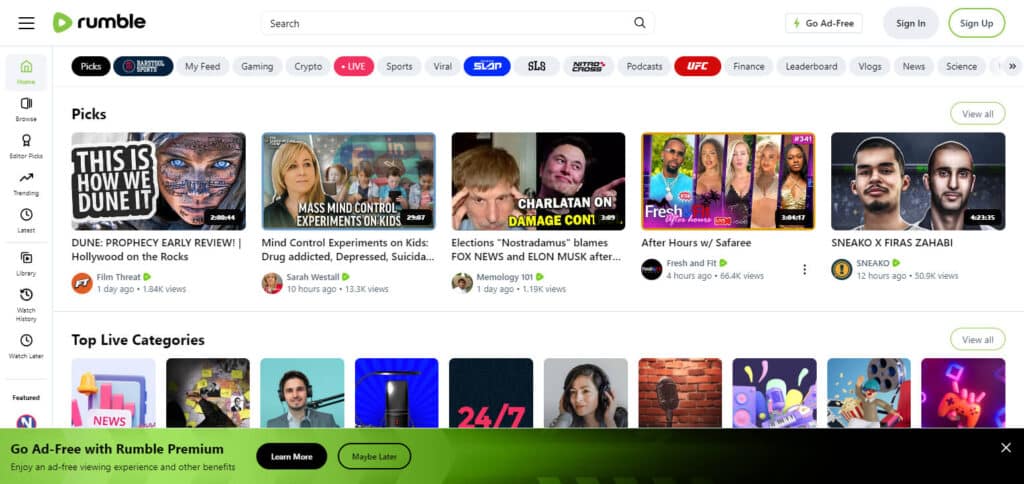I will discuss the Best Platform To Make Money With Videos in this article.
Video contents are now widely sought after by many creators, who are more than trying to find a way to monetize their work.
There is a multitude of platforms ranging from advertising revenue to engaging with brands and their fans. Let us look at the best platforms to earn income using videos.
Key Point & Best Platform To Make Money With Videos List
| Platform | Key Point |
|---|---|
| YouTube | Ad revenue, memberships, Super Chats |
| Twitch | Subscriptions, ads, donations |
| Vimeo | Pay-per-view, subscription-based earnings |
| Ad revenue, fan subscriptions | |
| LiveMe | Virtual gifts, ad revenue, fan support |
| Dailymotion | Revenue sharing through ads and premium content |
| Patreon | Monthly subscriptions from fans |
| Rumble | Ad revenue, content licensing |
| Storyfire | Ads, tips, subscriptions |
| Sponsored posts, ad revenue, brand partnerships |
10 Best Platforms to Make Money With Videos
1.YouTube
YouTube is undoubtedly the best platform for monetizing videos, including many earning options like advertisement, Super Chats, and memberships.
The YouTubers can make money through the YouTube Partner Program by monetizing their videos.

Viewers can send donations through Super Chats in live shows, and fans can subscribe to the paid content to access exclusive content.
Since YouTube has many users worldwide, there is a great chance for the creators to earn passive income.
YouTube Features
2. Twitch
Twitch is well known for its primary activity, live streaming, making it a great platform for creators who prefer doing real-time content.
The revenue model is quite diversified: subscriptions, ads, and donations. In this way, they can donate and even give gifts; for example, videos during the stream earnings of the creator are obtained through ads.

Also, there is a “Bits” mechanism in Twitch where users can send virtual gifts to creators, increasing revenue even more.
Twitch is almost everywhere among gamers but allows for other areas.
Twitch Features
3. Vimeo
Vimeo’s monetization alternatives are quite exceptional, concentrating on high-definition video hosting.
Users can get paid per view or simply by subscription, where they provide their videos or ongoing content.

Vimeo’s “On Demand” feature allows users to mark their videos at a price they choose.
It’s an excellent solution for experts who want to showcase their outputs or provide top-shelf products to targeted communities and have a clean, ad-free experience.
Vimeo Features
4. Facebook
Facebook is growing as a video monetizing platform that helps creators earn from advertisements and fan subscriptions.
The “In-Stream Ads” feature includes advertisements in videos and, thus, whisks away some revenue for creators of the videos dependent on the views.

By using the “Fan Subscriptions” feature on Facebook, fans who are ready to pay can get exclusive content from the creators.
Due to the massive amount of people who use Facebook, it offers the ability to reach a large audience; hence, it is a good choice for video monetization, especially for more specific content.
Facebook Features
5.LiveMe
LiveMe is one of the best platforms to monetize video content.
The platform allows creators to earn via virtual gifts, advertisement revenue, or from their fans.

It’s a live-streaming platform where viewers can instantly send gifts and exchange them for cash.
This platform also provides opportunities for creators to partner with brands and earn extra income through sponsorships.
LiveMe Features
6. Dailymotion
Dailymotion has model allows creators to profit from the advertising revenue share.

Ads in videos include pre-roll and banners, and mid-roll ads. Dailymotion also gives the ability to have a paid account for exclusive content and thus makes it possible to earn from subscriptions.
Dailymotion may not be as large as YouTube, but it provides a good revenue-sharing model, which is great for those seeking to expand their video monetization business models.
Dailymotion Features
7. Patreon
Patreon also enables creators to make money through monthly subscriptions. Fans can pay for exclusive content such as behind-the-scenes footage or early video access.

Patreon allows creators to shape a stable income by creating a group of dedicated fans. Creators can use flexible tiers and provide content according to the subscribed amount.
This platform is best for artists, musicians, and content creators who wish to have a stronger bond with their audience and earn money at all times.
Patreon Features
8. Rumble
Rumble has emerged as one of the fastest-expanding video platforms through which content creators can earn an income by both ad revenue and licensing their content.

Licensing their videos to a media platform gives the creators more income.
The platform has received a good reception for its easy monetization features and the potential for creators to distribute their videos widely, which can help them make money from multiple platforms.
Rumble Features
9. Storyfire
Storyfire is a video platform that helps content creators make money using various monetization methods such as ads, tips, or subscriptions.
The platform allows creators to upload videos and grow their revenue by monetizing ads on equipment.

Viewers can tip, which provides microtransactions during streams or watching videos.
Besides, exclusives can be wrapped behind a subscription fee which funds the creator.
Storyfire aims to give creators the tools they need to monetize effectively while making the community more engaging through unique features.
Storyfire Features
10. Instagram
Instagram is considered one of the best platforms, when it comes to earning money through videos.
Instagram monetization policies offer video creators an opportunity to earn money mainly from ads, sponsored posts, and brand partnerships.

There is room for video content on the platform, but In the form of snippets through Stories, short clips through reels, and IGTV, where their audience can consume the preferred content.
In turn, the audience size makes it attractive for brands looking for influencers, allowing video content creators to earn money from endorsing and selling products as affiliates and through direct sales.
Instagram’s business model also supports selling goods by creators on their videos directly.
Instagram Features
How To Select The Best Platform To Make Money With Videos
Audience Reach
Find a popular platform with many active users who fit your desired audience.
Monetization Options
Make Sure you find platforms with various means of income, from advertisements to memberships to product endorsements.
Content-Type
Find out which platforms are best for your content, if you make longer videos, shorter ones, or even streams.
Ease of Use
Use those platforms that are easy to navigate and have the necessary features for uploading, editing, or handling your content.
Revenue Potential
Each platform has a revenue-sharing ratio; look at them with the engagement rates, views, and ad revenues to know the long-term potential further.
Brand Collaborations
Go after those platforms that provide opportunities to work with brands for paid posts or even through affiliate marketing.
Community Engagement
Those platforms that enable communication with your subscribers can promote loyalty and offer new spheres for revenues.
Platform Support
Don’t forget to pay attention to how supportive the platform is and what it can offer, such as specialized programs and tools that help creators measure their success.
Conclusion
best platforms to make money with videos. Regarding content creation and monetization, opinions vary and can be narrowed down to the type of content, the targeted audience, and what kind of monetization is preferred.
For instance, Twitch and YouTube offer great opportunities for ad revenue and sponsorships, while TikTok is great for monetizing videos, considering their high sync partnerships.
Moreover, as with other options, Instagram accounts for more sales thanks to product or brand marketing, while Vimeo or Dailymotion have slightly better options.
YouTube monetization options depend on factors such as revenue sources, engagement, audience size, and many more, allowing the creator to decide which method is suited for him/her.

















Leave a Reply